
A monoplane is a fixed-wing aircraft configuration with a single mainplane, in contrast to a biplane or other types of multiplanes, which have multiple planes.

The RWD 3 was a 1930 Polish sports aircraft and liaison aircraft prototype, constructed by the RWD team, a single-engine high-wing monoplane.
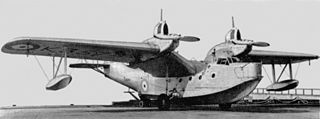
The Short R.24/31 was a British twin-engined, high-wing cantilever gull winged monoplane flying-boat designed and built by Short to Air Ministry specification R.24/31 for a "General Purpose Open Sea Patrol Flying Boat". The contract also specified the use of the experimental Rolls-Royce Goshawk engine. The Saunders-Roe London and the Supermarine Stranraer competed successfully for this contract.

The Goodyear GA-2 Duck was a 1940s American three-seat light amphibious aircraft built by the Goodyear Aircraft Corporation. The design team included David Thurston, who later developed several other light seaplanes including the Colonial Skimmer, Lake Buccaneer, Thurston Teal and Seafire. Only 19 aircraft were built, and these were used only for testing and as demonstrators.

The Supermarine Sea King was a British single-seat amphibious biplane fighter designed by Supermarine in 1919. Developed from the Supermarine Baby and the Supermarine Sea Lion I, the Sea King was a single seater biplane powered by a pusher 160 horsepower (120 kW) Beardmore engine. It first flew in early 1920 and was exhibited by Supermarine at the 1920 Olympia Show in London. The company released drawings of the aircraft's design prior to the show; what it exhibited was probably a modified Supermarine Baby.
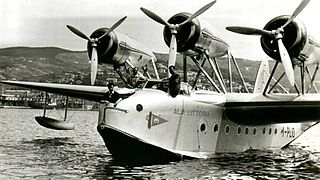
The Macchi M.C.100 was an Italian commercial flying boat designed and built by Macchi.
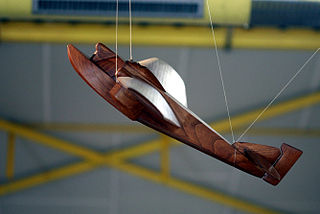
The Richard-Penhoët 2 was a 1926 French, large, five-engined flying-boat airliner, carrying up to twenty passengers. The sole example flew in 1926 but was lost in 1928 during testing after modification to improve performance.
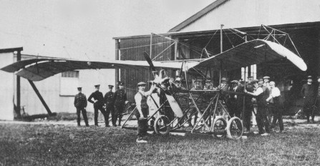
The Dunne D.7 was one of J. W. Dunne's swept wing tailless aircraft designed to have automatic stability, first flying in 1911. It was a single seat, single engined pusher monoplane developed from the unsuccessful D.6.
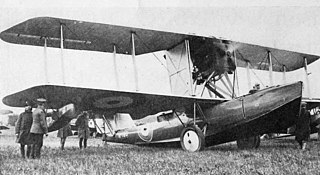
The Supermarine Sheldrake was a British amphibian biplane flying boat developed by Supermarine from the Supermarine Seagull with a revised hull. It was powered by a Napier Lion engine mounted between the wings driving a four-bladed propeller. Only one Sheldrake, serial number N180, was built.

The ASL Viking was a single-engined two seater biplane aircraft designed and built by Horatio Barber's Aeronautical Syndicate Ltd. at Hendon. It was first flown in January 1912.
The Aeromarine AMC was the first American all-metal hulled commercial flying boat.

The Gabardini monoplane was a successful early monoplane constructed in Italy which made several notable flights, often carrying passengers, just before World War I. During the war, a number of lower-powered Gabardini monoplanes served as a training aircraft for the military.
The Pegna-Bonmartini Rondine, or Pegna Rondine, is a single-seat ultralight sport aeroplane designed by Giovanni Pegna and built by Piaggio in Italy during 1923.
The Euler Hydro-triplane was an unusual pusher configuration amphibious triplane flying boat, built in Germany in 1913.

The Rohrbach Ro VII Robbe was an all-metal, twin engine flying boat built in Germany in the 1920s. It could be adapted to commercial or military rôles.

The four-engined Lioré et Olivier LeO H-27 was one of three French flying boats competing to carry mail over Air France's South Atlantic routes. Flying later than its competitors, it was not selected and only one was built.

The Boland 1911 Conventional Biplane was an American pioneering aircraft.

The Boland 1912 Tailless Biplane was a refinement of the Boland 1911 Tailless Biplane. The major change in the 1912 biplane is the addition of a central nacelle that contained the pilot, passenger and the engine.

The Zeppelin-Lindau Gs.I, often known post-WWI as the Dornier Gs.I after its designer Claude Dornier, was a civil flying boat developed immediate post-war from a military prototype. Its passenger cabin seated six. Only one was completed, and that was eventually scuttled to keep it out of Allied hands. Another of the military prototypes was intended to have a bigger, nine seat cabin and other refinements but the Gs.II was incomplete when discovered by Allied inspectors.

The Ireland Privateer was a 1930s American two-seat, single pusher-engined monoplane sports flying boat which could be equipped as an amphibian. About 18 were built.


















